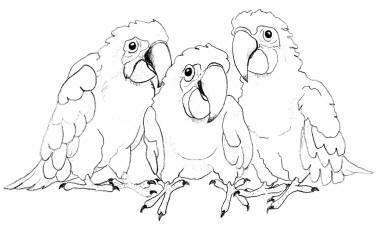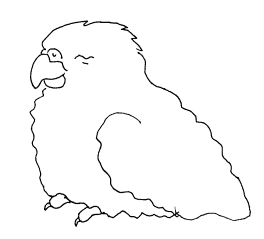|
What is this Bappy Word?
by Sally Blanchard
This
article is copyrighted and may not be reprinted without the written permission
of Sally Blanchard or the PBIC, Inc. Contact us for permission.

Interestingly, the word "Bappy" is both one of the most loved and hated aspects
of the Pet Bird Report.
Some people love the word and have started to use it freely—not just in the
PBR. Others hate the word and some even use it as a way to attack the Pet Bird
Report and its entire contents.
One self-proclaimed expert on the Internet continually attacks the word
whenever anyone uses it proclaiming that anyone who would be idiotic enough to
make up such a word has no credibility about birds.
When I first introduced the word in an article in 1992 (issue #6 of the Pet
Bird Report) in an article entitled 'How's Your Bappy?' (article follows), I was
using it only as a suggestion to make a point.
Some people loved the word and considered it an endearing term for their
beloved parrots. It caught on and several writers use it in their PBR articles
now. Through the years, I have received several letters on this topic. Most,
whether positive or negative, have been logical and friendly while others have
been mean-spirited or dismiss the entire Pet Bird Report simply because of its
use of the word. While many readers were uncomfortable with the word at first,
several letter writers report becoming fond of the term "bappy" as they have
become used to it. Since I make a policy of not editing the content of most of
the articles in the PBR, I always leave it in while other bird magazines edit
the word out because it is not a universally accepted word.
My feeling about the word "bappy"?—if you like it, use it—if you don't like
it don't use it. But certainly whether a person uses it in their articles or not
should not be the decisive factor in determining their credibility. I certainly
have no ego-investment in the use of the word "bappy" but find it a very
convenient term when I write articles about what makes the parrots we share out
lives with so special. The following is the article in which I first presented
the word "bappy".

How's Your Bappy?
by Sally Blanchard
Reprinted from The Pet Bird Report Issue #6, July/August 1992. May not be used
without permission.
Puppy, Kitty?
There is nothing cuter than a frisky little puppy except maybe a furry ball
of a kitten. I've often heard folks lament, "the trouble with puppies (kittens)
is that they grow up to be dogs (cats). The same realities are absolutely true
with human babies that are "oh so cuddly" but eventually grow up to be either
well-adjusted or juvenile delinquent teenagers (or something in between) on
their way to adulthood.
Mammal babies are quite different in appearance and
behavior from their adult counterparts. It is very obvious when they are babies
and quite evident that they will not continue to look or act the same as they
grow up. There are even words for the babies of dogs and cats which we humans
often keep as pets.
What Is A Baby Parrot Called?
We generally call them the usual, not too imaginative "baby parrot." Sometimes
we call them chicks. But then, that is what most baby birds of all species are
called—aren't baby parrots something special? Since there is no specific word
for a baby parrot, I made up the word "Bappy". I may start using it in my
articles. People may think I am crazy? If you all don't like the word—that's
fine. If you have a better suggestion—send it to me. I think that I've thought
of most possibilities and personally dismissed them for one reason or another
but I could be wrong. The word "Bappy" probably sounds funny just because it
really isn't a word—yet? The dictionary is full of all sorts of new words that
sounded strange when people first started using them. Some of them still sound
strange!
Why Does It Matter?
Why does it matter if there is an actual word for a baby parrot? We can continue
to call them baby parrots, can't we? Sure, if we want to. But I think that the
fact that there is no special term for a baby parrot may create some
misconceptions, especially for the novice bird owner. After all, if you don't
really know that a bappy (baby parrot, OK?) is soft and cuddly with velvety
shiny feathers, clumsy little rubbery feet and innocent inquisitive eyes that
can melt the heart of all but the most "production oriented" breeders, then you
may not be able to tell the difference. After all, once a "bappy" fledges or
starts to fly, it has all of its feathers and is about the same size as it will
be as an adult. Of course, those of us who have been around parrots for awhile
know that those intensely curious eyes change colors in some species as a "bappy"
matures. But many people have to be around parrots for awhile to learn the real
differences and novices simply may not realize that their new parrot will change
behaviorally as it gets older.
Why Does This Create Problems?
One of the major problems I see in working with behavioral problems in human
raised parrots is that the owners weren't able to think of their new parrots as
babies. Well, they actually knew that they were babies but somehow the
connection was not made in their consciousness that baby parrots grow up.
Perhaps because the changes in appearance as a "bappy" matures are not as
obvious as with other pets, people assume without thinking that their behavior
will not change! This is a major misconception that creates endless problems for
bird owners with their parrots. I always tell my clients with "bappies" that
providing guidance, rules, and using the "UP" and "DOWN" commands will establish
a "Nurturing Guidance" that will keep their parrot tame and loving as it
matures. But too often, I am called a year or so later to deal with a biting,
screaming, one-person, cage-bound, confused "monster" in control of its own life
(and doing a poor job of it!). The response of the equally confused owner is
that since the bird was so sweet, he or she didn't need to use the "UP" command
or set rules. Somehow or other the connection was not made, no matter how hard l
tried to make it, that their parrot was a baby when they bought it and it WOULD
grow up and change behaviors just like the kittens and puppies they were more
acquainted with.
What Something Is Called Defines It
I have been convinced for a long time that the labels given something have a
great effect on the way that we perceive things. For example, for years the
bowls that birds eat out of have been called "seed cups". I am convinced that
this is at least one of the many reasons that seed has been mistakenly thought
of as the correct food for caged birds for so long. For that reason, I try to be
very careful to say "food cup" instead. Everyone always talks about "fruits and
vegetables" when in reality, it is the vegetables that are the most important
source of nutrients for captive birds. So maybe we should try and say
"vegetables and fruits" instead. If we had a word for a baby parrot, it might
help the novice differentiate a baby from an adult parrot. It might also help
people stay in touch with the fact that their new parrot is still a "bappy"
until it is anywhere from 6 months to 2 years old de-pending on the species! It
just makes sense to me that if there are special names for baby dogs and baby
cats, its about time that we had a special name for baby parrots!
If this
article helped you and you appreciated the information, The Companion Parrot
Quarterly continues to have in-depth, practical articles such as this one.
PLEASE
SUBSCRIBE
|
